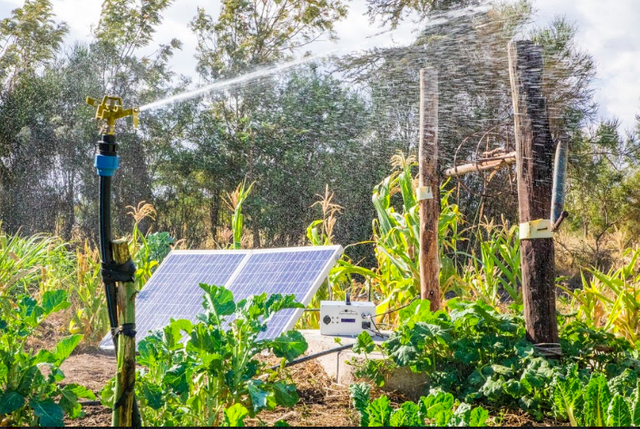Club100💪|| Irrigation Technologies And It's Benefits To Farming||club5050💪
Water is one of the most essential elements that supports life of living things. About seventy percent (70%) of the human body consists of water whiles in plants the percentage of water is about ninety percent (90%). Humans beings still depend on some sources of water outside the body to fulfil the water requirements.
Plants as well require water for growth. The process of supplying water to the plants by man is termed as irrigation.
Irrigation is the process of watering (applying water to the crops) by man to fulfil their water requirements. Nutrients are also supplied to crops via irrigation. Common sources of water for irrigation include wells, ponds, lakes, canals, tube-wells, dams etc. Irrigation offers moisture required for plants growth and development, germination and photosynthesis.

The rate, development, amount and time of irrigation may vary for different crops owing to the type of soil and seasons. For instance, in summer, crops require more water as compared to winter.
We shall consider types of irrigation and the methods used for irrigation.
There are numerous types of Irrigation that practiced to improve crops yield.
Various types of irrigation systems are practised based on the different types of soils, climates, crops and resources.
The main types of irrigation adopted by farmers include:

Surface Irrigation
In this system, no irrigation pump is employed. Water supplied to crops across the land by gravity.
Localized Irrigation
In this system of irrigation water is supplied to plants through a network of pipelines under low pressure.
Sprinkler Irrigation
With this type, water is distributed from a central location by sprinklers to the moving crops.

Drip Irrigation
In this type, drops of water are distributed near the roots of the crops. This mode of water supply (Irrigation) is uncommon because it requires frequent maintenance.
Centre Pivot Irrigation
Here, water is delivered by a sprinkler system moving in a spiral pattern.
Sub Irrigation
This type employs a water distribution method through a system of pump stations, ditches etc. by elevating the water table.
Manual Irrigation
This is labour intensive and time-consuming system of irrigation. Water is supplied to plants by using watering cans.

Inadequate and unreliable rainfall adversely affects agriculture. Droughts and famines are as a result to low among of rainfall recorded. Irrigation increases productivity even in low rainfall.
Produce produced on and irrigated farmland is higher compared to solely relying on rainfall.
Irrigation facilities allows farmers to cultivate more a couple of crops in most areas across the country.
Irrigation again allows farmlands that were left to fallow under cultivation.
Irrigation increases the availability of water supply, and increases the yields of crops which in the long run increases income of farmers.

The dependence on other countries for importing crops will reduce when irrigation is put in practice. At times the climate is unfavorable and affects crop production greatly. Irrigation must be optimized because over-irrigation can destroy crop production. Excess water results to waterlogging, hinders germination of seeds, increases salt concentration in the soil. Farmers must adopt appropriate methods of irrigation to achieve best yields.
My regards
.png)
Note: You must enter the tag #fintech among the first 4 tags for your post to be reviewed.
Thank you for the support
Hi friend, great to have you on this platform. Such amazing post. Steem on!
Thank you
Thank you for sharing friend. Steem on!
You are welcome